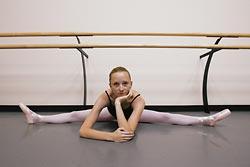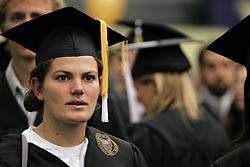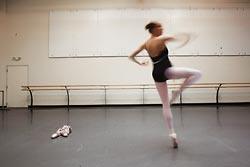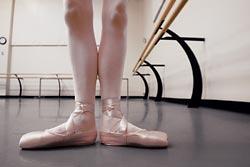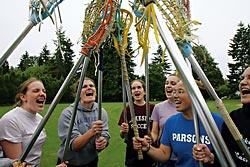Still Looking

A LULLING OCEAN breeze wafts in and stirs with the blanketing warmth sifting down through high shredded clouds. The tide has hiked up its shirt, exposing a belly of sand about 100 yards deep along Pacific Beach. All in all, it is a fine day and a lovely place to hunt for dead birds.
Jane Dolliver, 23, leads Ben Watson, a volunteer bird-carcass surveyor more than twice her age, up and down the beach. They zigzag, squint and scan a landscape mottled with seaweed, footprints, crab shells, pop cans.
Over three hours or so, they find 10 corpses, all of which they tag, record and photograph, adding to an exhaustive database. Some birds look as if they have churned through a washing machine. Sometimes, head and body lie apart. Sometimes, there is no head at all. So Dolliver and Watson analyze clues, from wing and beak length to colors and feet profiles, and refer to a book nicknamed "Dead Birds for Dummies."
The bird count helps answer environmental questions. A massive die-off could mean changes in prey abundance, pollution levels or a variety of other factors. But simple baseline numbers help, too.
Dolliver, who graduated from the University of Washington last year, has been working with COASST (Coastal Observation and Seabird Survey Team) the past four. The first three were as a student. She gets paid a little through a grant, and believes in this project and citizen-assisted science. But she won't be counting dead pigeon guillemots forever. In fact, when she talks about this project and her love of science, she describes her career approach and — indirectly — that of many others in her generation.
"In science, your thoughts about a given system are constantly evolving," she says. "Once you think you have things figured out, you find the exception. That's what makes it so exciting. Beginning a career in marine biology doesn't mean mastering a technique or specializing in a given skill; it's much less confining."
She represents an overlooked but healthy Northwest niche among recent graduates and the young workforce that belong to the so-called millennial generation (born as far back as 1980 or 1982).
Members of her sub-group don't jump like previous generations with a splash into the employment stream. They tend to wade in, tentative, testing for slippery rocks. They are not the slackers we hear about or the corporate climbers, either. They aren't delaying for the sake of a last bout of good times before the cubicle, but are moving deliberately, with long-range purpose. They reflect the get-a-life values of their aging baby-boomer parents, who ironically often dove head-first into work when they were young, even into jobs they didn't want.
Work is different today. So is the world. It's faster, smaller and less certain. It's meaner, too. While their parents are especially nurturing (sometimes alarmingly so), companies are that much colder.
Millennials grew up the busiest, most time-structured generation of children in history. In a provocative article published early this year, Time magazine studied these delay issues and pronounced that the period between 18 and 25 has evolved into a distinct life stage, a limbo between adolescence and adulthood. In 2000, according to the last available census numbers, 25 percent of Americans between 18 and 34 lived with their parents. That number has certainly swelled, and the young adults get names like "boomerang kids" and "twixters."
Some demographers say this group is benefiting not only from those doting parents but from a long period of affluence, social liberation and digital access, all of which allow them to explore paths at a leisurely pace. Some worry that the delay shows a lack of fire. But you can't discount economics. It is expensive out there.
And while this generation has unique skills and a wider, deeper view of the lives they want, they also face opportunities, competition, alternatives, complications, costs, doubts and pressures the likes of which their parents never imagined.
Experts agree that members of this generation, on the whole, look before they leap — even facing steep student loans and a murky career landscape. A popular book among 20-somethings the last few years, "Quarterlife Crisis: The Unique Challenges of Life in Your Twenties," describes the situation: Unlike the midlife crisis, in which the 50-year-old wistfully looks back on missed opportunities, the quarterlife crisis is partly driven by the overload and consequent confusion of too many choices.
With its portrait of "the real world" as a scary place, the book hit the New York Times best-seller list and a chord with young people. But it represents just one take on their generation. Dolliver and many others who gravitate toward environmental work especially don't seem spooked. They are not delaying the real world so much as they're looking to make the world they are entering more real.
THE OLDEST OF the millennials began college on the eve of the terrorist attacks hitting our shore. Many, confused and alarmed by the worldwide threat, uncertainty and America's polarization, are gravitating toward international studies.
"They want to reshape policy," says Andrea Boulanger, director of Career Services in the Evans School of Public Affairs at the University of Washington. "It's only a guess, but I think the kids in the millennial generation become more aware about the world at an early age. They are exposed to more and travel more than previous generations."The year before the terrorist attacks, 9 percent of the incoming class at the Evans School of Public Affairs declared international affairs as their "concentration." That number more than doubled each of the next two years. The interest doesn't necessarily mean government work. A recent survey of 805 college seniors found that only one in five of those who claimed to be more patriotic because of 9/11 said they are interested in working for the government.
Students don't hold government jobs in very high esteem, says Max Stier, president and chief executive of Partnership for Public Service, which commissioned the study, partly because they worry they won't be able to repay their college loans on government salaries. But they also see promotions coming too slowly and the opportunities to make a difference impinged by bureaucratic red tape.
Peace Corps applications, however, are booming, and Seattle has long been a hotbed for the organization. In fact, the UW was third among all universities last year in the number of volunteers, and is perennially near the top of the list.
Shannon Smith, 23, is heading to Paraguay, a long way from Mill Creek, where she spent half her life. She graduated from the UW in the spring with honors and with degrees in ecological biology and economics. She coached the junior-varsity lacrosse team at Lakeside, is well-spoken and dislikes wasting time. In other words, she is quite employable. But she felt the Peace Corps offered the right package and the right time, and spent the summer waiting tables and hiking in Montana before learning the details of her 2 ½-year stint.
"I've felt sheltered, I guess," she says. "I wanted to experience something completely different and use my skills to help — dig wells, build houses, work in an orphanage, whatever. There are so many things I want to do, and whether it is with environmental policy or teaching, I will get a lot of direction from this. It should help me in the long run decide what I want to do with my life, get a job and learn about the real world. Maybe I'll stay. Maybe I will come back and work for a nonprofit or apply for grad school."
Smith emphasizes making a difference, like shaping environmental policy. She has done hard-core field research and lab work, but found focusing on the narrow questions lacking. She needs the bigger picture, the why behind the what.
In her "motivation statement" given to the Peace Corps, she said: "I have become increasingly interested in international policy and its relationship to development." But as she prepared to leave, she voiced a less gung-ho, more realistic attitude: "Am I going to do any good? Will I make things worse instead of better? I am concerned about the issue of cultural imperialism, where we come in and say we know what we're doing and you don't."
Her parents are nervous both about her security and the delaying of her career. She, too, is concerned. Yet she believes two-plus years in the Peace Corps will help her get a grasp on who she is and what she not only wants to do but is meant to do. (She found out last month that she will be teaching environmental education in the South American country.)
"I suppose some potential employers might be bothered I didn't rush out and get in the workforce after graduation. But," she says with a chuckle, "I wouldn't want to work for those people anyway."
ANOTHER BOOK IS making the rounds with 20-somethings. "Delaying the Real World: a Twentysomething's Guide to Seeking Adventure" encourages young people to take advantage of their youth before settling into a career. "Don't be in such a rush to be boring!" is how author Colleen Kinder puts it.
Delay strikes some older folks as a synonym for avoidance. Kinder, 23, argues that adventures away from the routine and safety of campus motivate young people to discover who they are and what they want to do and be. Kinder pursued her own form of delay with a fellowship in Cuba, and while there realized she worked better for and by herself. She also realized she was in a narrow window before she settled into the earn-and-spend cycle. She began researching her book idea, interviewing young adults doing similar things.
"No one," she says, "regretted it."
Still, freedom and stress are common bedfellows. In addition to writing, Kinder works as a fact-checker, a cat-sitter and a baby-sitter while pursuing the freelance life.
Kimberly Genther, 24, graduated from the UW last year and spent almost a year teaching at a South Carolina environmental-education center. She's back at home with her parents in Redmond, trying to decide where she wants to spend the next four years of graduate school.
She has a degree in aquatics and fishery sciences, and her ultimate goal is to be "the next Jane Goodall." But first, she wants to dance.
"Most people in my major go right into grad school or a research position," she says. "I want my Ph.D. eventually, but I'm not ready for that. I'm at a crossroads. I'm torn between performing arts and scientific fields. Society says pick and choose, but it is hard to choose what you want to be for the rest of your life. A lot of people are having multiple careers these days, I know."
But, she adds, "I don't want to nail myself into a corner. I have options. I want to make sure I pick the right one."
So she splits time between lab and clerical work for a UW oceanography professor and dancing ballet with Arc Dance Productions, a Seattle repertoire company. Dancing is a young person's profession, and as much as she plans to excel in her eventual field, she also holds out dreams of joining Cirque du Soleil or Broadway musical theater.
She is able to do this in great part because her parents allow her to live at home, something far more common among this group of young graduates than among their parents' generation. Other than the stint in South Carolina, she has lived with her parents her whole life.
Kathryn Hamilton, director of the UW Counseling Center, also worked with students in the late '70s and '80s. She says the latest generation dramatically differs when it comes to balance:
"It's not being lazy. They are just more aware and assertive about time off and integrating various phases of their lives. Many students in the '80s were more focused on career. This group looks more at interpersonal issues."
Abby Wilner, who co-wrote "Quarterlife Crisis," says the boomers got married earlier and jumped into a career they stayed with thanks in part to corporate cultures far more loyal than they are now. These days, she says, she and her fellow young people are not only taking time to explore all the various career options, they are also taking longer to get through the dating scene in order to avoid their parents' divorce rate. "It may seem easy to say, 'Just relax, enjoy your freedom and quit whining,' but every decision we make now about our careers, grad school and families will impact our futures."
Happiness is a key consideration.
Nate Lewis, a Seattle 25-year-old, received his biochemistry degree two years ago. But even as he steamed toward graduation, he realized he didn't really want to be a biochemist. So he does inventory for a souvenir store company, Simply Seattle, splitting time between data entry and moving boxes.
He has always been interested in science but worries about being confined. He felt he'd get bored pursuing the work for which he trained.
"I wouldn't have to worry about money as much if I was working in a job in my field," he says. "But making an extra $10,000 a year and being miserable wouldn't make it worth it."
DOLLIVER ALSO WENT to college with the idea of becoming a chemist, but found it paled next to the panorama of possibilities in biology and zoology. So, like Smith and Genther, she widened her view. While she coordinates dead-bird hunting, her work for COASST has also presented an exquisite front seat for seeing bird life.
Through the summer, she made several trips to Tatoosh Island, a dank, wet, windy rock at the very corner of the continental United States. Researchers often get just a glimpse of sun before the fog swallows them. But birds are the only view they care about. Dolliver and others monitor, among other things, the reproductive effort and breeding success of common murres, small black-and-white seabirds that lay eggs each June.
"My 'cubicle' has a 360-degree view of the Strait of Juan de Fuca and the northern Washington coast," Dolliver says. "On my lunch break, I might just see a flock of 20 brown pelicans glide past 'the office.' Of course, you never have to worry about getting soaked or guano'd if you work indoors, but that's a small price to pay."
As she develops her plan, whether island biology or studying invasive species, she gathers data not just on birds but on what kind of scientist she is meant to be and what graduate program can help her get there. Many young people of color or of immigrant families don't have the luxury of time. They need to focus on earning. Like Genther, Dolliver owes her parents for putting her up as she nudges closer to her decision.
When she was in sixth grade, her parents were asked to enter in her journal the hardest thing about parenthood. Her father wrote:
"The difficulty is not taking ownership of another, or expecting others to be as the parent wants them. If the parent gets in the way, the child never grows into herself, but a mirror of the parent. The hard part must be letting go."
Richard Seven is a Pacific Northwest magazine staff writer. He can be reached at rseven@seattletimes.com. Alan Berner is a Seattle Times staff photographer.

